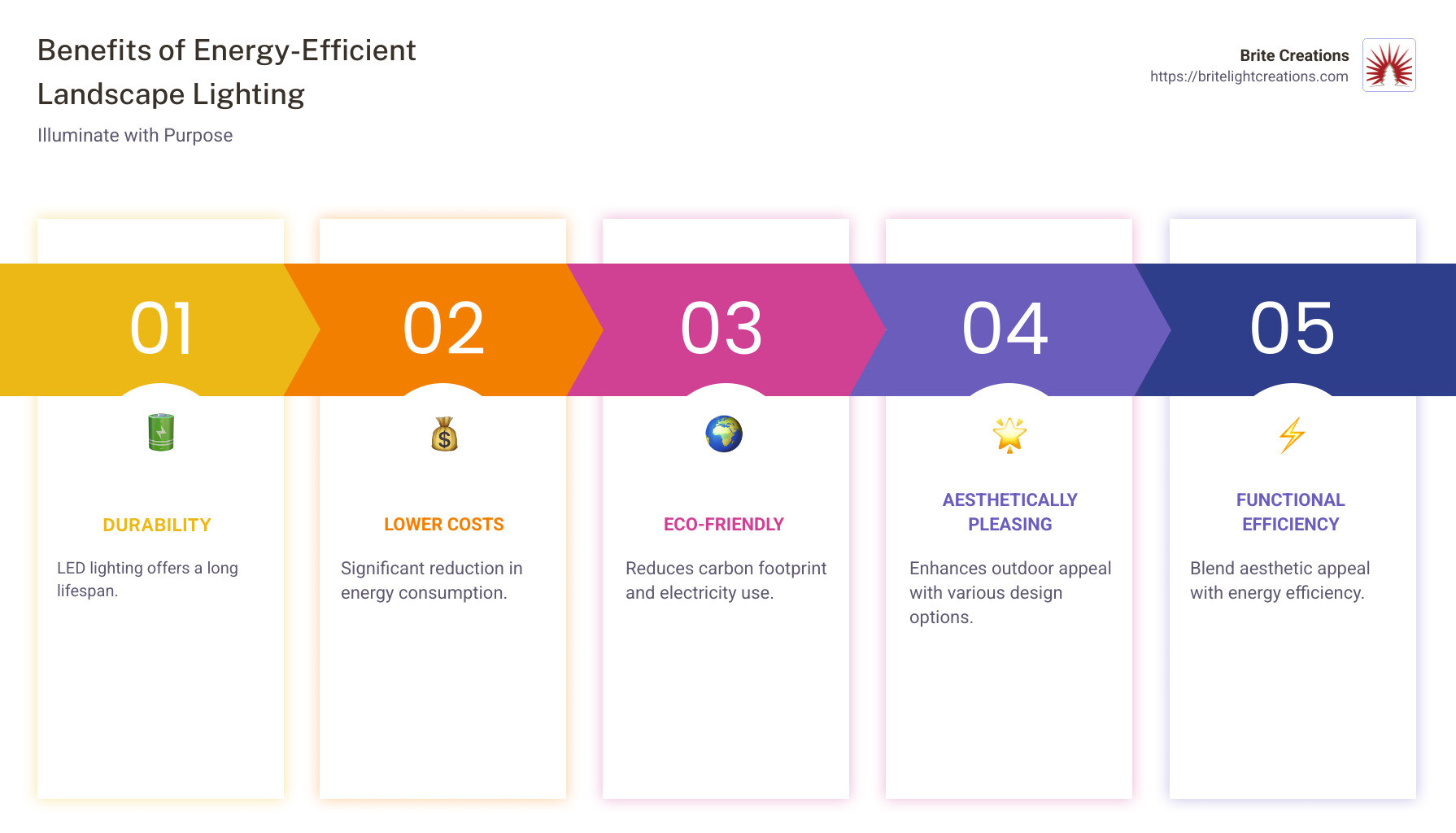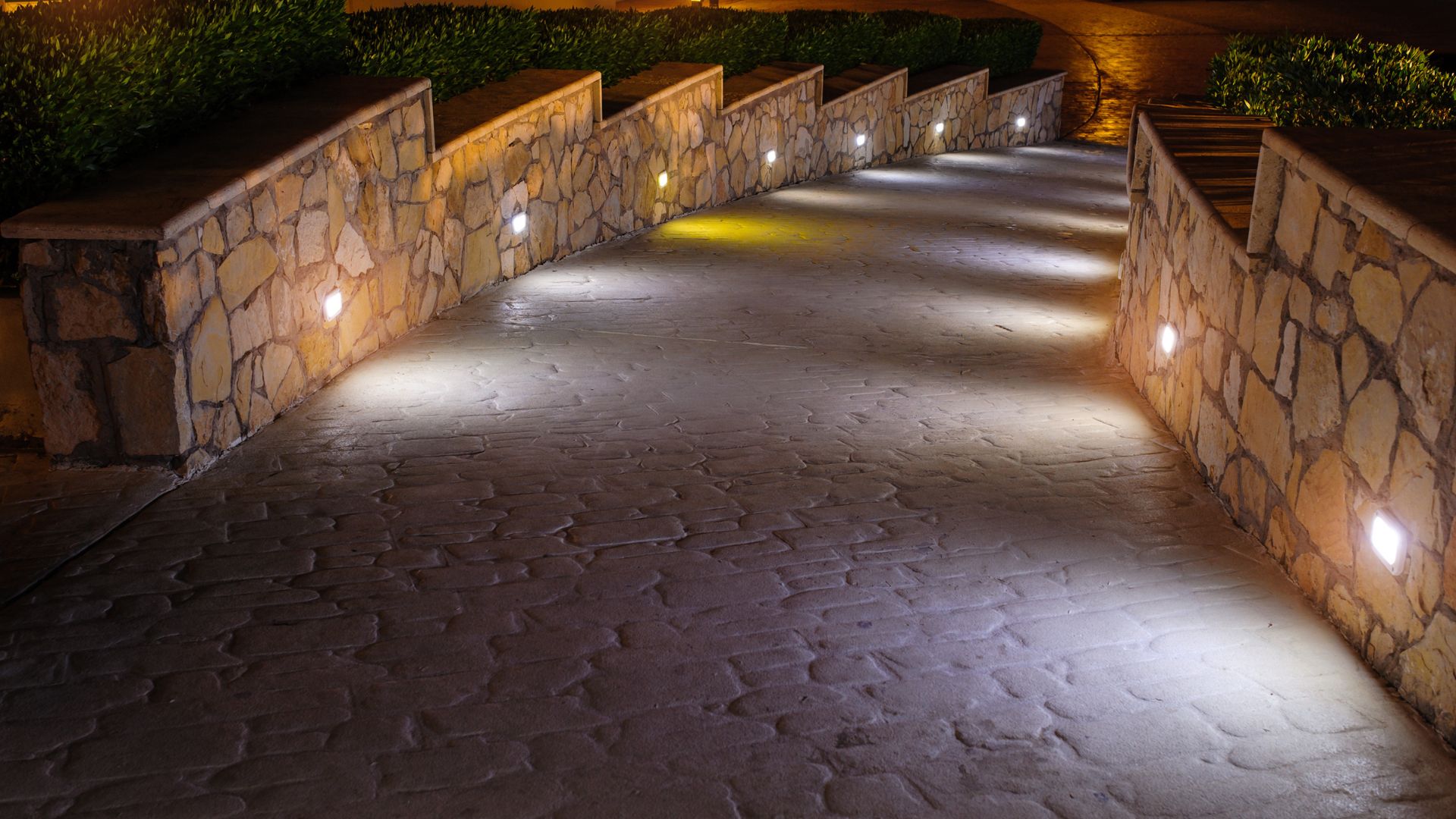Energy-efficient landscape lighting is more than just a way to illuminate your outdoor space—it’s a blend of beauty, cost savings, and sustainability. Imagine highlighting the architectural elegance of your garden while reducing your electricity bill and contributing to a cleaner planet. Here’s a quick dive into why energy-efficient landscape lighting is a smart choice:
- Durability: LED lighting offers a long lifespan.
- Lower costs: Significant reduction in energy consumption.
- Eco-friendly: Reduces carbon footprint and electricity use.
- Aesthetically pleasing: Improves outdoor appeal with various design options.
Choosing the right lighting can transform your backyard into an inviting retreat, save money, and promote environmental responsibility. As you consider this upgrade, the benefits are manifold—your home’s exterior can shine brightly without affecting the planet or your wallet.
I’m Jimmy Tompkins, the President of Brite Creations, specializing in energy-efficient landscape lighting. With years of experience providing eco-friendly lighting solutions, my team and I are here to help you blend aesthetic appeal with functional efficiency. Stay tuned as we explore more effective solutions for your lighting needs.

Understanding Energy-Efficient Landscape Lighting
Energy-efficient landscape lighting is a game-changer for anyone looking to illuminate their outdoor space while being mindful of energy consumption. At the heart of this efficiency is LED technology. Unlike traditional incandescent bulbs, LEDs use a semiconductor to emit light, which makes them much more efficient. They consume up to 75% less energy and can last up to 25 times longer. This means fewer bulb changes and lower electricity bills.

Another key component is the use of low voltage systems. Most energy-efficient landscape lighting operates on 12 volts, compared to the standard 120 volts. This not only saves energy but also improves safety. With low voltage, the risk of electrical shock is minimized, making it safer for DIY installations and maintenance.
The energy savings from using LED and low voltage systems are substantial. By switching to these technologies, homeowners can significantly cut down their energy use. This results in lower electricity bills and a reduced carbon footprint. It’s a win-win for your wallet and the environment.
Incorporating energy-efficient lighting into your landscape isn’t just about saving money. It’s about making a conscious choice to reduce energy consumption and promote sustainability. Whether you’re lighting up a garden path or highlighting a favorite tree, energy-efficient landscape lighting offers a smart and responsible way to beautify your outdoor spaces.
Next, let’s explore some top tips for maximizing the efficiency of your landscape lighting.
Top Tips for Energy-Efficient Landscape Lighting
Leverage LED Bulbs
LED bulbs are the heroes of energy-efficient landscape lighting. They use up to 80% less energy than traditional incandescent bulbs and can last over 50,000 hours. That’s about 25 times longer than those old-fashioned bulbs. This means fewer replacements and less waste, saving you money and reducing landfill contributions.
LEDs are versatile, offering various brightness levels and color temperatures. Whether you need soft ambient light or bright task lighting, LEDs have you covered. Plus, they don’t emit harmful UV rays, making them a safer choice for your garden.
Use Low Voltage Systems
Switching to a 12-volt system is another smart move. These systems are not only energy-efficient but also safer. The lower voltage reduces the risk of electrical shock, making it ideal for DIY projects.
Low voltage systems are perfect for landscape lighting. They use less energy, which translates to lower utility bills. And since they are safer, you can install them in areas where children or pets play without worry.
Implement Motion Sensors and Timers
Motion sensors and timers are fantastic tools for energy conservation. They ensure your lights are only on when needed, saving energy and extending the life of your bulbs.
Motion sensors add an extra layer of security. They light up when someone approaches, deterring potential intruders. Timers can be set to turn lights on at dusk and off at dawn, offering convenience and energy savings.
Optimize Light Placement and Height
Effective light placement and varying heights can significantly improve your lighting efficiency. By strategically placing lights, you can achieve effective distribution that minimizes dark spots without over-lighting.
Proper placement also helps in reducing light pollution. Aim lights downward or shield them to prevent unnecessary upward light spill. This not only saves energy but also protects the night sky.
Consider Solar-Powered Options
Solar-powered lights are an eco-friendly option worth considering. They harness the sun’s energy during the day and illuminate your landscape at night, all without using electricity. This makes them both sustainable and cost-effective.
However, solar lights do depend on sunlight, so their effectiveness can vary based on location and weather. They may require occasional battery replacements, but the trade-off for using renewable energy is worth it for many homeowners.
Incorporating these tips can help you create a beautifully lit and energy-efficient outdoor space. Next, we’ll dig into the benefits of choosing energy-efficient landscape lighting.
Benefits of Energy-Efficient Landscape Lighting
Choosing energy-efficient landscape lighting offers numerous advantages that go beyond just illuminating your outdoor space. Let’s explore the key benefits:
Energy Savings
Energy-efficient landscape lighting significantly reduces electricity consumption. LED lights, for example, use up to 80% less energy than traditional incandescent bulbs. This translates to lower electricity bills and a smaller carbon footprint. When you switch to energy-efficient lighting, you’re not just saving energy; you’re saving money too.

Environmental Impact
Using energy-efficient lighting options like LEDs and solar lights helps reduce your environmental impact. Traditional lighting systems often rely on fossil fuels, contributing to greenhouse gas emissions. By choosing LEDs, which are free of harmful materials like mercury, you minimize these emissions and help combat climate change.
Moreover, solar-powered lights rely on renewable energy from the sun, making them an eco-friendly choice. They reduce dependency on non-renewable energy sources, further decreasing your environmental footprint.
Durability
LED lights are known for their durability. They are resistant to shock, vibrations, and extreme weather conditions, making them ideal for outdoor use. This durability means fewer replacements, which not only saves money but also reduces waste.
LEDs also have a longer lifespan, lasting up to 50,000 hours. This longevity ensures that your outdoor lighting system remains functional and efficient for years, providing reliable illumination without frequent maintenance.
By understanding these benefits, you can make informed decisions about your outdoor lighting. In the next section, we’ll answer some frequently asked questions about energy-efficient landscape lighting.
Frequently Asked Questions about Energy-Efficient Landscape Lighting
Do landscape lights use a lot of electricity?
Not when you choose LED technology. LED lights are incredibly efficient, using up to 80% less energy than traditional incandescent bulbs. This means your landscape lighting will have a minimal impact on your electricity bill. For example, a typical LED bulb might use only 4 to 12 watts, compared to the 60 watts that incandescent bulbs require. This low consumption makes LEDs the go-to choice for energy-conscious homeowners.
What are the disadvantages of solar outdoor lights?
While solar lights are a fantastic eco-friendly option, they do come with a few drawbacks. Sun dependency is a primary concern. Since solar lights rely on sunlight to charge, their performance can vary depending on the amount of sun exposure they receive. On cloudy days or in shaded areas, they may not charge fully, leading to dimmer lights at night.
Another consideration is battery replacement. Solar lights use rechargeable batteries that eventually wear out and need replacing. This maintenance aspect is something to keep in mind, though it’s worth noting that battery technology is continually improving, extending the lifespan of these components.
Which type of lighting is most energy-efficient?
When it comes to energy efficiency, LED technology stands out as the best option. LEDs not only consume less power but also have a longer lifespan compared to other types of lighting, such as Compact Fluorescent Lamps (CFLs). While CFLs are more efficient than incandescent bulbs, they still fall short of the efficiency and longevity that LEDs provide. Additionally, LEDs do not contain mercury, which is a concern with CFLs, making them a safer and more environmentally friendly choice.
By understanding these key points, you can make informed decisions about your landscape lighting options. Next, we’ll explore how to tailor your lighting solutions to fit your specific needs with the help of Brite Creations.
Conclusion
At Brite Creations, we understand that every landscape is unique, and that’s why we offer customized solutions custom to your specific needs. Whether you’re looking to improve the beauty of your garden or improve security, our team of experts is ready to help you achieve your goals with energy-efficient landscape lighting.
Located in the heart of Raleigh, NC, we proudly serve the surrounding areas, including Cary, Chapel Hill, and Durham. Our commitment to energy efficiency means you can enjoy stunning outdoor illumination without the hefty energy bills. We specialize in using the latest LED technology and low-voltage systems to ensure your landscape shines bright while saving energy.
Our process begins with a thorough assessment of your property. We consider factors like light placement, height, and the use of motion sensors and timers to optimize energy use. This approach not only improves the aesthetic appeal of your outdoor spaces but also reduces light pollution and conserves energy.
If you’re ready to transform your landscape with energy-efficient lighting, contact us today. Let Brite Creations light up your world with sustainable and beautiful solutions designed just for you.


